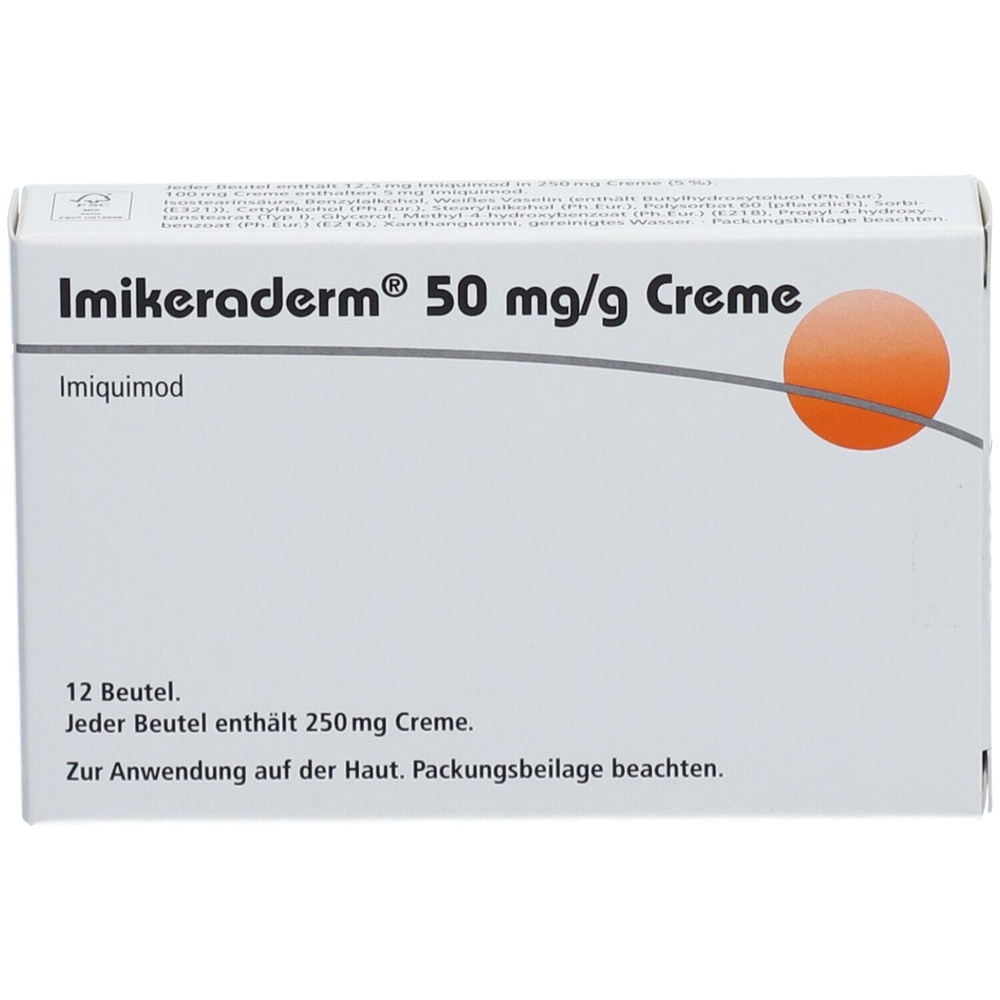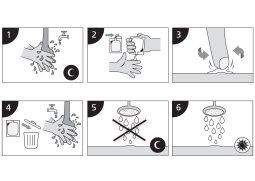

ІМІКЕРАДЕРМ 50 мг/г КРЕМ

Запитайте лікаря про рецепт на ІМІКЕРАДЕРМ 50 мг/г КРЕМ

Інструкція із застосування ІМІКЕРАДЕРМ 50 мг/г КРЕМ
Вступ
Опис: інформація для користувача
Імікерадерм 50 мг/г крем
Імікімод
Прочитайте уважно весь опис перед тим, як почати використовувати цей лікарський засіб, оскільки він містить важливу інформацію для вас.
- Збережіть цей опис, оскільки вам може знадобитися знову його прочитати.
- Якщо у вас є якісь сумніви, проконсультуйтеся з вашим лікарем або фармацевтом.
- Цей лікарський засіб призначений тільки для вас, і не слід давати його іншим людям, навіть якщо вони мають相同ні симптоми, оскільки це може їм нашкодити.
- Якщо ви відчуваєте побічні ефекти, проконсультуйтеся з вашим лікарем або фармацевтом, навіть якщо це побічні ефекти, які не вказані в цьому описі. Див. розділ 4.
Зміст опису:
- Що таке Імікерадерм і для чого він використовується
- Що потрібно знати перед тим, як почати використовувати Імікерадерм
- Як використовувати Імікерадерм
- Можливі побічні ефекти
- Зберігання Імікерадерму
- Зміст упаковки та додаткова інформація
1. Що таке Імікерадерм і для чого він використовується
Імікерадерм призначений для лікування актинічної кератози.
Актинічна кератоза складається з шорстких зон шкіри, які з'являються у людей, які тривалий час піддавалися дії сонячного світла. Деякі з них мають колір шкіри, інші - сіруватий, рожевий, червоний або коричневий. Вони можуть бути гладкими і лускатими, або опуклими, твердими і бородавчастими. Імікерадерм слід використовувати виключно для гладкої актинічної кератози на обличчі та шкірі голови у пацієнтів з здоровою імунною системою, коли лікар вирішує, що Імікерадерм є найвідповіднішим лікуванням.
Імікерадерм допомагає власній імунній системі організму виробляти природні речовини, які допомагають боротися з актинічною кератозою.
2. Що потрібно знати перед тим, як почати використовувати Імікерадерм
Не використовувати Імікерадерм
- якщо ви алергічні на імікімод або на будь-який інший компонент цього лікарського засобу (перелічені в розділі 6).
Попередження та застереження
Проконсультуйтеся з вашим лікарем або фармацевтом перед тим, як почати використовувати імікімод-крем.
- Якщо ви раніше використовували імікімод-крем або інші подібні препарати, вам слід проконсультуватися з лікарем перед тим, як почати це лікування.
- Якщо у вас є аутоімунні розлади.
- Якщо у вас був трансплант органу.
- Не слід використовувати імікімод-крем до тих пір, поки зона лікування не загоїться після попереднього фармакологічного або хірургічного лікування.
- Уникайте контакту з очима, губами та ніздрями. У разі випадкового контакту видаліть крем, промившись водою.
- Не застосовуйте крем всередину.
- Не слід використовувати більше крему, ніж порадив ваш лікар.
- Не накривайте зону лікування бинтами або іншими пов'язками після застосування імікімод-крему.
- Якщо на зоні лікування з'являються надто сильні неприємні відчуття, вам слід видалити крем м'яким милом та водою.
Як тільки проблема буде вирішена, ви можете знову застосувати крем.
- Повідомте вашому лікареві, якщо у вас є зміни в аналізі крові.
Через механізм дії імікімод-крему існує можливість того, що крем може загострити існуючий запалення в зоні лікування.
Не слід використовувати лампи для засмаги чи апарати для засмаги та уникайте сонячного світла якомога більше під час лікування імікімод-кремом. Для виходу з дому використовуйте захисну одяг та широкополічні капелюхи.
Під час використання імікімод-крему та до загоєння зони лікування ймовірно, що зона лікування матиме досить відмінний вигляд порівняно зі здоровою шкірою.
Діти та підлітки
Не рекомендується для використання у дітей та підлітків.
Інші лікарські засоби та Імікерадерм
Повідомте вашому лікареві або фармацевту, якщо ви використовуєте, нещодавно використовували або можете використовувати інші лікарські засоби.
Не відомо лікарських засобів, які є не сумісними з імікімод-кремом.
Вагітність та годування грудьми
Якщо ви вагітні або годуєте грудьми, вважаєте, що можете бути вагітною або плануєте вагітність, проконсультуйтеся з вашим лікарем або фармацевтом перед тим, як використовувати цей лікарський засіб.
Вам слід повідомити вашому лікареві, якщо ви вагітні або плануєте вагітність. Лікар оцінить ризики та переваги використання імікімод-крему під час вагітності. Дослідження на тваринах не показали прямого або непрямого шкідливого впливу під час вагітності.
Не годуйте грудьми під час використання імікімод-крему, оскільки не відомо, чи виділяється імікімод з грудним молоком.
Водіння транспортних засобів та використання машин
Цей лікарський засіб має незначний або відсутній вплив на здатність водити транспортні засоби та використовувати машини.
Імікерадерм містить пара-гідроксибензоат метилу та пара-гідроксибензоат пропілу (Е218 та Е216)
Пара-гідроксибензоат метилу (Е218) та пара-гідроксибензоат пропілу (Е216) можуть викликати алергічні реакції (можливо, затримані).
Імікерадерм містить цетиловий спирт та стеариловий спирт
Цетиловий спирт та стеариловий спирт можуть викликати місцеві реакції на шкірі (наприклад, контактний дерматит).
Імікерадерм містить бензиловий спирт
Цей лікарський засіб містить 5 мг бензилового спирту в кожному пакеті. Бензиловий спирт може викликати алергічні реакції та місцеве подразнення.
Імікерадерм містить бутілгідрокситолуен (Е321)
Бутілгідрокситолуен (Е321) може викликати місцеві реакції на шкірі (наприклад, контактний дерматит) або подразнення очей та слизових оболонок.
3. Як використовувати Імікерадерм
Діти та підлітки:
Не рекомендується для використання у дітей та підлітків.
Дорослі:
Слідуйте точно інструкціям щодо застосування цього лікарського засобу, вказаним вашим лікарем. У разі сумнівів проконсультуйтеся з вашим лікарем або фармацевтом.
Мийте руки ретельно перед та після застосування крему. Не накривайте зону лікування бинтами або іншими пов'язками після застосування імікімод-крему.
Відкривайте новий пакет кожен раз, коли застосовуєте крем. Витрачайте весь крем, який залишається в пакеті після застосування. Не зберігаєте відкритий пакет для використання в інший день.
Інструкції щодо застосування Імікерадерму

Інструкції щодо застосування: - (пн, ср, пт)
- Перед сном мийте руки та зону лікування м'яким милом та водою. Добре висушуйте.
- Відкривайте новий пакет та нанесіть невелику кількість крему на кінчик пальця.
- Нанесіть імікімод-крем на уражену зону. Розтягайте його м'яко по зоні, поки крем не зникне.
- Після застосування крему викиньте відкритий пакет та мийте руки водою та милом.
- Залишайте імікімод-крем на шкірі протягом близько 8 годин. Під час цього часу не приймайте душ чи ванну.
- Після близько 8 годин мийте зону, на яку нанесли імікімод-крем, м'яким милом та водою.
Застосовуйте імікімод-крем 3 рази на тиждень. Наприклад, застосовуйте крем у понеділок, середу та п'ятницю. Один пакет містить достатню кількість крему для покриття площі 25 см². Продовжуйте лікування протягом 4 тижнів. Через 4 тижні після закінчення першого курсу лікування ваш лікар оцінить стан вашої шкіри. Якщо не всі ураження зникли, можуть знадобитися ще 4 тижні лікування.
Якщо ви використовуєте більше Імікерадерму, ніж потрібно
Видаліть надлишок крему водою та м'яким милом. Коли зникне реакція шкіри, ви можете продовжити лікування.
У разі випадкової інгестії імікімоду проконсультуйтеся з вашим лікарем.
У разі передозування або випадкової інгестії негайно проконсультуйтеся з вашим лікарем або фармацевтом або зверніться до Токсикологічної служби, телефон 91 562 04 20, вказавши назву лікарського засобу та кількість, яку ви прийняли.
Якщо ви забули застосувати Імікерадерм
Якщо ви забули одну дозу, застосуйте крем якнайшвидше та продовжуйте звичайний режим лікування.
Не застосовуйте крем більше одного разу на добу.
Якщо у вас є якісь інші питання щодо використання цього лікарського засобу, проконсультуйтеся з вашим лікарем або фармацевтом.
4. Можливі побічні ефекти
Як і всі лікарські засоби, цей лікарський засіб може викликати побічні ефекти, хоча не всі люди їх відчувають.
Проконсультуйтеся з вашим лікарем або фармацевтом, якщо ви не відчуваєте себе добре під час застосування імікімоду.
Деякі пацієнти мали зміни кольору шкіри в зоні застосування імікімоду. Хоча ці зміни зазвичай покращуються з часом, вони можуть бути постійними у деяких пацієнтів. Якщо ваша шкіра має побічну реакцію на імікімод-крем, зупіньте застосування крему, промийте зону водою та м'яким милом та проконсультуйтеся з вашим лікарем або фармацевтом.
У деяких осіб виявлена зниження кількості кров'яних тільць. Зниження кількості кров'яних тільць може зробити вас більш схильними до інфекцій, спричинити легше утворення синяків або викликати втому. Якщо ви відчуваєте будь-які з цих симптомів, повідомте вашому лікареві.
Деякі пацієнти, які мають аутоімунні розлади, можуть відчувати загострення своєї хвороби. Проконсультуйтеся з вашим лікарем, якщо ви відчуваєте будь-які зміни під час лікування імікімод-кремом.
У рідких випадках спостерігалися серйозні дерматологічні реакції. Зупіньте лікування імікімод-кремом та негайно проконсультуйтеся з вашим лікарем, якщо ви відчуваєте шкірні ураження або плями на шкірі, які починаються як маленькі червоні зони та розвиваються у маленькі цілі з можливим запаленням, лихоманкою, загальним нездоров'ям, проблемами з зором, печією, опуклістю очей або болем у роті.
У деяких пацієнтів спостерігалася втрата волосся в зоні лікування або навколо неї.
Багато побічних ефектів імікімод-крему пов'язані з місцевим впливом на вашу шкіру. Місцеві шкірні реакції можуть бути ознакою того, що лікарський засіб діє так, як очікувалося.
Часто спостерігаються (виявлені у більш ніж 1 з 10 пацієнтів).
Частошкіра, яку лікують, може мати легкий свербіж.
Часто (виявлені у менш ніж 1 з 10 пацієнтів).
Часті ефективключають: біль, печію, подразнення, або червоність.
Якщо будь-яка шкірна реакція стає надто неприємною під час лікування, проконсультуйтеся з вашим лікарем. Лікар може порадити вам тимчасово припинити застосування імікімод-крему (тобто, зробити коротку перерву в лікуванні). Якщо з'являється гній або інші ознаки інфекції, повідомте вашому лікареві. Окрім шкірних реакцій, інші часті ефекти включають головний біль, анорексію, нудоту, біль у м'язах та суглобах та втому.
Рідко (виявлені у менш ніж 1 з 100 пацієнтів).
Рідкодеякі пацієнти відчувають зміни в місці застосування (кровотеча, запалення, виділення, чутливість, опуклість, маленькі запальні зони на шкірі, оніміння, утворення луски, утворення рубців, виразки або відчуття тепла чи дискомфорту), або запалення шкіри, яка покриває ніс, закладення носа, грип або псевдогрипозні симптоми, депресію, подразнення очей, запалення повік, біль у горлі, діарею, актинічну кератозу, червоність, опуклість обличчя, виразки, біль у кінцівках, лихоманку, слабкість або тремтячі рухи.
Повідомлення про побічні ефекти
Якщо ви відчуваєте будь-який побічний ефект, проконсультуйтеся з вашим лікарем або фармацевтом, навіть якщо це можливі побічні ефекти, які не вказані в цьому описі. Ви також можете повідомити про них безпосередньо через Систему фармакологічного нагляду за лікарськими засобами для людини: https://www.notificaram.es. Повідомляючи про побічні ефекти, ви можете допомогти надати більше інформації про безпеку цього лікарського засобу.
5. Зберігання Імікерадерму
Тримайте цей лікарський засіб поза досяжністю дітей.
Не зберігаючи при температурі вище 25 °C.
Не використовуйте цей лікарський засіб після закінчення терміну придатності, вказаного на зовнішній упаковці та на етикетці після EXP. Термін придатності відноситься до останнього дня цього місяця.
Після відкриття пакетів не слід знову використовувати.
Лікарські засоби не слід викидати у водопровід чи сміття. Відкладайте упаковки та лікарські засоби, які вам не потрібні, у спеціальний пункт збору в аптеці. Спитайте у вашого фармацевта, як позбутися упаковок та лікарських засобів, які вам не потрібні. Таким чином, ви допоможете захистити навколишнє середовище.
6. Зміст упаковки та додаткова інформація
Склад Імікерадерму
Активний інгредієнт:
Імікімод
Кожен пакет містить 250 мг крему (100 мг крему містять 5 мг імікімоду).
Інші інгредієнти:
Ізостеарова кислота, бензиловий спирт, біла вазелін (стабілізована бутілгідрокситолуеном Е321), цетиловий спирт, стеариловий спирт, полісорбат 60, сорбітановий стеарат типу I, гліцерол, пара-гідроксибензоат метилу (Е 218), пара-гідроксибензоат пропілу (Е 216), ксантанову камедь та очищена вода (див. також розділ 2 «Імікерадерм 50 мг/г крем містить пара-гідроксибензоат метилу, пара-гідроксибензоат пропілу, цетиловий спирт, стеариловий спирт, бензиловий спирт та бутілгідрокситолуен»).
Вигляд продукту та вміст упаковки
Кожен пакет Імікерадерму містить 250 мг білого або жовтуватого крему. Кожна упаковка містить 12 або 24 пакети з поліестеру/паперу для алюмінію для одного використання.
Можливо, що тільки деякі розміри упаковок будуть випущені на ринок.
Власник дозволу на продаж та відповідальна особа за виробництво
Власник дозволу на продаж:
Mibe Pharma Іспанія S.L.U.
C/Amaltea 9, 4-а поверх, літера Б,
28045, Мадрид
Іспанія
Відповідальна особа за виробництво
Mibe GmbH Arzneimittel
Münchener Straße 15
06796 Бренна
Німеччина
або
Sun-Farm Sp. z o.o.
Ul. Dolna 21, Ломянкі
05-092 Мазовецьке
Польща
Дата останнього перегляду цього опису: Травень 2022
Детальна інформація про цей лікарський засіб доступна на сайті Агентства лікарських засобів та медичних продуктів Іспанії (AEMPS) (http://www.aemps.gob.es/).

Скільки коштує ІМІКЕРАДЕРМ 50 мг/г КРЕМ в Іспанії у 2025 році?
ІМІКЕРАДЕРМ 50 мг/г КРЕМ коштує в середньому 37.78 євро у листопад, 2025 році. Ціна може змінюватися залежно від регіону, аптеки та наявності рецепта. Рекомендуємо перевіряти актуальну вартість у місцевих аптеках або через онлайн-сервіси.
- Країна реєстрації
- Середня ціна в аптеках37.78 EUR
- Діючі речовини
- Потрібен рецептТак
- Виробник
- Інформація є довідковою і не є медичною порадою. Перед прийомом будь-яких препаратів обов'язково проконсультуйтеся з лікарем. Oladoctor не несе відповідальності за медичні рішення, прийняті на основі цього контенту.
- Альтернативи до ІМІКЕРАДЕРМ 50 мг/г КРЕМФорма випуску: КРЕМ, 50 мг/гДіючі речовини: imiquimodВиробник: Viatris Healthcare LimitedПотрібен рецептФорма випуску: КРЕМ, 50 мг/гДіючі речовини: imiquimodВиробник: Viatris Healthcare LimitedПотрібен рецептФорма випуску: КРЕМ, 50 мг/гДіючі речовини: imiquimodВиробник: Industrial Farmaceutica Cantabria S.A.Потрібен рецепт
Аналоги ІМІКЕРАДЕРМ 50 мг/г КРЕМ в інших країнах
Найкращі аналоги з тією самою діючою речовиною та терапевтичним ефектом.
Аналог ІМІКЕРАДЕРМ 50 мг/г КРЕМ у Польща
Аналог ІМІКЕРАДЕРМ 50 мг/г КРЕМ у Україна
Лікарі онлайн щодо ІМІКЕРАДЕРМ 50 мг/г КРЕМ
Консультація щодо дозування, побічних ефектів, взаємодій, протипоказань та поновлення рецепта на ІМІКЕРАДЕРМ 50 мг/г КРЕМ – за рішенням лікаря та згідно з місцевими правилами.






